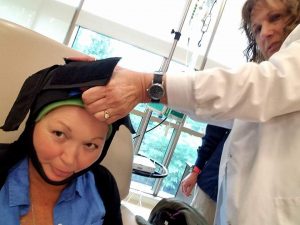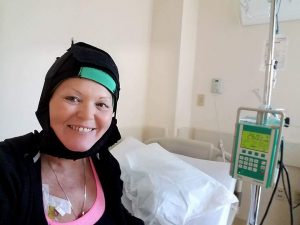When I think of pioneers, I think of beef jerky, primitive cooking supplies, and hearts full of hope. I picture covered wagons and Laura Ingalls Wilder wearing a charming bonnet while her dog frolics through oversized grass.
But after today, I have a new image of a pioneer. Her name is Connie Waldt.
She’s a bartender at Chug A Mug in Baltimore, Maryland, and I could almost taste the beer and feel the bar’s atmosphere in her voice while we talked on the phone. I imagine a quick-witted lady who can handle herself, someone who knows how to pour a drink and when not to. As Connie described her workplace, I could see her regulars sitting on bar stools, mugs in hand, passing pleasant hours while snow flurries danced over nearby sidewalks.
So what makes this bartender a pioneer?
She’s done something remarkable, something brave and beautiful.
It’s something that required extra effort at a time when she was very ill. She had to endure discomfort, take a risk, and spend hard-earned money. And she had to accept a lot of help from others, a challenge in and of itself.
When she decided to take it on, she didn’t really even know what she was getting into.
“I saw a flyer in my doctor’s office,” she said, “and I asked her, ‘What’s this?’”
In life’s quirky tendency to put us in exactly the right place at the right time, Connie happened to be with the only physician at the time in Maryland who approved her patients to use DigniCaps. (Full disclosure: A representative of DigniCaps maker Dignitana contacted me to put me in touch with Connie.)
Pointing at the brochure, Dr. Young Lee explained the cold caps, which can help patients save their hair during chemo. Dr. Lee is an oncologist, and she was treating Connie for breast cancer.
“I’m in,” Connie said. “I don’t need to look like a beauty queen, but it would be great to look normal.”

So, when Connie started chemotherapy, she arrived for her first session early and took a look at the machine. “It’s about waist-high,” she described, and it’s on wheels. It has a long tube like a vacuum cleaner hose attached to a boxy contraption on one end and a green helmet-like hat on the other.”
The vacuum hose feeds icy air into the cap so it can chill the patient’s head. Cancer fighters wear it before chemo infusion begins. They keep it on throughout the session and for an hour or so afterward. The idea is that if your scalp is frozen, chemo meds won’t circulate there, so you won’t lose your hair. According to BreastCancer.org, cold caps and scalp cooling systems are effective about 65 percent of the time.
“My friends and I spritzed my head with water, but I didn’t think it got wet enough,” Connie told me. “Finally, I dunked my head in a sink. Then, I pushed that icy helmet on my head while a nurse pulled it tight using the chin straps.”

To make the technology work, the cap has to fit snugly. That’s why they come in three different sizes. It’s also most effective if the hair is glommed onto the scalp so that cold gets as close to the skin as possible — that’s why getting hair damp is encouraged.
“Yes, it’s icy,” Connie said. “But it’s not unbearable. Think of it as an ice cream freeze. After a while, I didn’t really even notice it and I was able to fall asleep with it on.”


(Photos courtesy of Connie Waldt)
Over the course of six chemo sessions, Connie donned the cap. She’d huddle under a heated blanket, read a magazine, chat with friends, nap, and get infused with those powerful lifesaving chemo meds.
“I wanted to keep working as much as I could, even during chemotherapy,” Connie said. “And since bartending puts me in front of the public, I knew it would be easier if I didn’t have to show up either bald or in a wig.”

“Besides, I knew there’s a chance I wasn’t going to survive,” she said. “And I decided that if I’m going to die, I want people to see me for who I am. I don’t want to be the ‘scary grandma’ whose body looks ill. I wanted to live or die being as close to ‘me’ as possible.”
DigniCaps currently cost about $400 per session. Connie’s regular customers, who knew about her ordeal, tipped her generously to help her bear the cost. One guy named Danny slid his credit card in the tip jar and said, “It’s good for one session.” Connie laughed when she told me the story, but I knew she was also wiping away a tear.
Cancer does that. It butts up what’s worst in life with what’s best in life and mixes it all together.
Her hair? As beautiful on the day she finished chemo as it was on the day she started. Progress. Pioneer’s progress.
More about scalp cooling
Currently, two companies in the U.S. have been cleared by the FDA to provide scalp-cooling technologies for certain types of cancer patients: Paxman Scalp Cooling and Dignitana (Dignicap).
Approximately 65 percent of patients using Paxman and Dignitana systems kept at least 50 percent of their hair, according to studies. The system’s success varies depending on which chemotherapies are used, the number of chemo sessions patients require, and other factors. Patients need to know that scalp cooling doesn’t always work.
Paxman and Dignitana use machines to deliver iced caps to patients undergoing chemotherapy. Other systems, like Penguin Cold Caps, require patients to use dry ice and coolers to freeze the caps themselves.
The cost of using scalp-cooling technology typically ranges from $1,500 to $3,000.
Some physicians caution patients against scalp cooling due to the risk that cancer might make its way to the scalp regions where chemo meds don’t reach. As with any medical procedure, each patient is different, and you should always discuss your options with a doctor.
***
Note: Breast Cancer News is strictly a news and information website about the disease. It does not provide medical advice, diagnosis, or treatment. This content is not intended to be a substitute for professional medical advice, diagnosis, or treatment. Always seek the advice of your physician or other qualified health provider with any questions you may have regarding a medical condition. Never disregard professional medical advice or delay in seeking it because of something you have read on this website. The opinions expressed in this column are not those of Breast Cancer News, or its parent company, BioNews Services, and are intended to spark discussion about issues pertaining to breast cancer.


